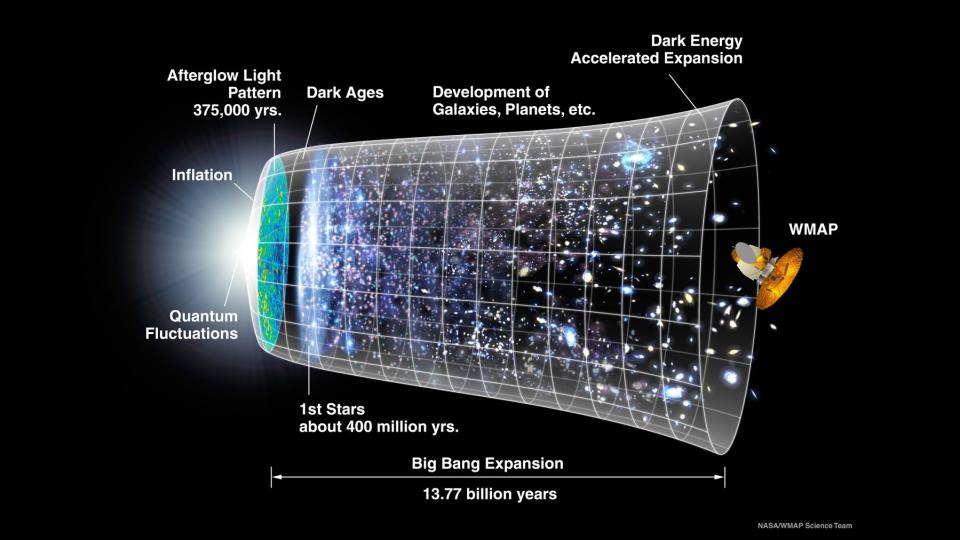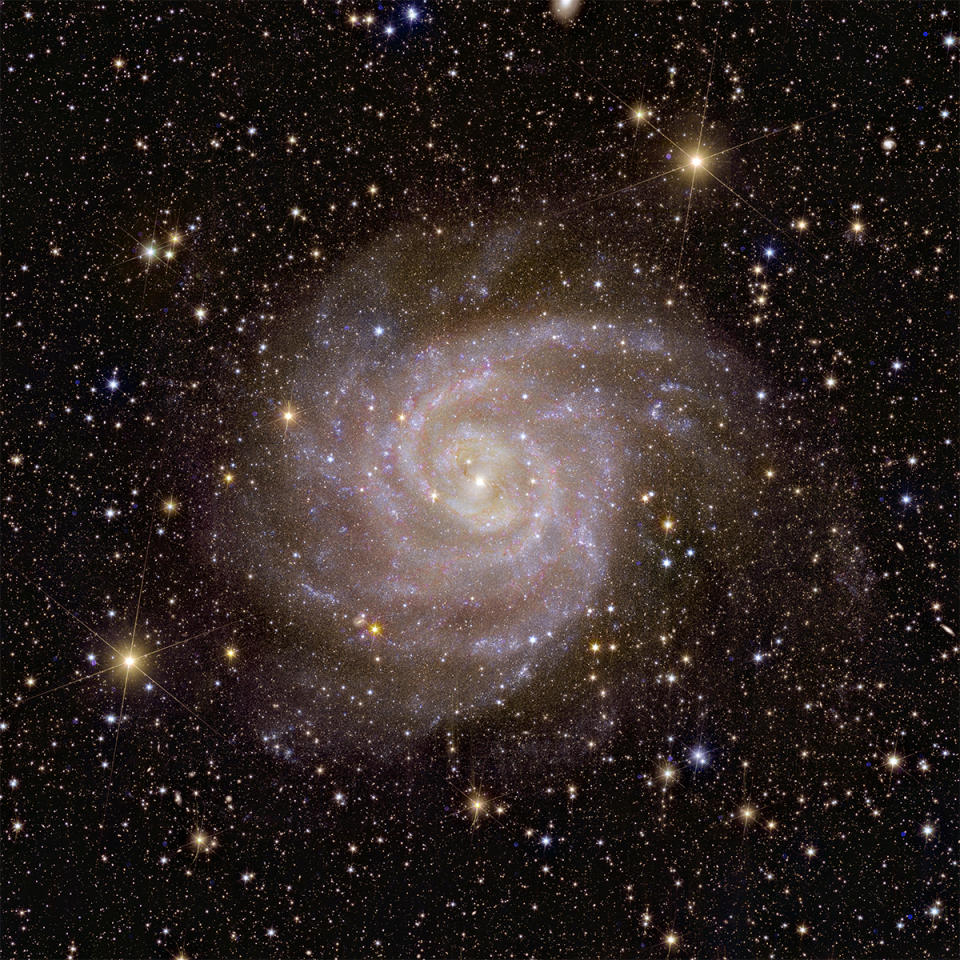As people struggle to understand dark energy, the mysterious force driving the accelerated expansion of the universe, scientists are beginning to wonder about something rather futuristic. Can computers do better? Well, initial results from a team that used artificial intelligence (AI) techniques to infer the influence of dark energy with unprecedented precision may suggest an answer: yes.
The team, led by scientist Niall Jeffrey from University College London, worked with the Dark Energy Survey collaboration to use measurements of visible matter and dark matter to create a supercomputer simulation of the universe. While dark energy pushes the universe outward in all directions, dark matter is a mysterious form of matter that remains invisible because it does not interact with light.
After creating the cosmic simulation, the crew then used AI to create an accurate map of the universe covering the past seven billion years and showing the actions of dark energy. The team’s resulting data represents a whopping 100 million galaxies spread across about 25% of the sky in Earth’s southern hemisphere. Without AI, creating such a map using this data, which represents the first three years of observations from the Dark Energy Survey, would have required many more observations. The findings help validate which models of cosmic evolution are viable when combined with dark energy dynamics, while ruling out other models that may not be.
“Compared to using old-fashioned methods to learn about dark energy through these data maps, using this AI approach ultimately doubled our accuracy in measuring dark energy,” Jeffrey told Space.com. ‘With the standard method you need four times as much data.
Related: ‘Axion stars’ that boomed after the Big Bang could shed light on dark matter
“If you wanted to achieve this level of precision and understanding of dark energy without AI,” Jeffrey added, “you would have to collect the same data three more times in different parts of the sky. This would amount to mapping an additional 300 million galaxies.”
The problem with dark energy
Dark energy is a kind of placeholder name for the mysterious force that is accelerating the expansion of the universe, pushing distant galaxies away from the Milky Way and each other faster and faster over time.
The current period of ‘cosmic inflation’ is separate from that which followed the birth of the universe after the Big Bang; it appears to have begun after the initial expansion had stalled.
Imagine giving a child one push on a swing. The swing slows down after that initial force is added, but instead of coming to a stop, without you pushing again, the swing suddenly starts moving again. That in itself would be quite strange, but there is actually more. The swing also began to speed up after the movement was suddenly restarted, reaching increasingly greater heights and speeds. This is similar to what happens in space, where the universe bubbles out instead of a swing that moves back and forth.
You’d probably love to understand what added that extra ‘push’ and caused the acceleration. Scientists feel the same way about whatever dark energy is, and how it seems to have given an extra cosmic boost to the fabric of space.
This desire is compounded by the fact that dark energy accounts for about 70% of the universe’s energy and matter budget, even though we don’t know what that is. If we take into account the dark matter, which accounts for 25% of this budget and cannot be made up of atoms that we know – the atoms that make up stars, planets, moons, neutron stars, our body and the neighbor’s cat exist – we may only have truly visible access to about 5% of the entire universe.
‘We really don’t understand what dark energy is; it’s one of those weird things. It’s just a word we use to describe some kind of extra force in the universe that pushes everything away from each other as the universe’s expansion continues to accelerate. Jeffery said. “The Dark Energy Survey is trying to understand what dark energy is. The main thing we’re trying to do is ask the question: Is it a cosmological constant?”

The cosmological constant, represented by the Greek letter lambda, has quite a rich history for cosmologists. Albert Einstein first introduced it to ensure that the equations of his revolutionary 1915 theory of gravity, general relativity, supported what is known as a “static universe.”
However, this concept was called into question when observations of distant galaxies by Edwin Hubble showed that the universe is expanding and thus expanding further and further. not static. Einstein threw the cosmological constant into the scientific dustbin, reportedly describing it as his “greatest blunder.”
However, in 1998, two separate teams of astronomers observed distant supernovae and discovered that not only was the universe expanding, but it also appeared to be accelerating. Dark energy was invented to explain the force behind this acceleration, and the cosmological constant was fished out of the hypothetical dustbin.
Now the cosmological constant lambda represents the background vacuum energy of the universe, which acts almost as an ‘anti-gravity’ force driving its expansion. As of now, the cosmological constant is the main evidence for dark energy.
“Our results, compared to using standard methods with the same dark matter map, tighten up, and we found that this is still consistent with dark energy being explained by a cosmological constant,” Jeffrey said. “So with this result we have ruled out some physical models of dark energy.”
However, this does not mean that the mysteries of dark energy – or the headache that the cosmological constant represents – have been illuminated.
‘The worst prediction in the history of physics’
The cosmological constant still poses a huge problem for scientists.
That’s because observations of distant, receding celestial bodies suggest a lambda value that is 120 orders of magnitude (10 followed by 119 zeros) smaller than what is predicted by quantum physics. It is therefore not without reason that the cosmological constant has been described by some scientists as ‘the worst theoretical prediction in the history of physics’.
Jeffrey is clear: no matter how happy the team is with these results, this research cannot yet explain the enormous gap between theory and observation.
“That disparity is simply too great and tells us that our quantum mechanical theory is wrong,” he continued. “What these results can tell us is what kind of equations or what kind of physical models describe the way our universe is expanding and how gravity works, pulling together everything made of matter in the universe.”
Even though the team’s results suggest that general relativity is the correct recipe for gravity, it cannot rule out other potential gravity models that could explain the observed effects of dark energy.
“At first glance, just looking at these results is consistent with general relativity – yet there is a lot of wiggle room because it also allows for other theories about how dark energy or gravity works,” Jeffrey said.


This research demonstrates the utility of using AI to assess simulated models of the universe, discovering important patterns that humans may miss, and thus looking for important clues to dark energy.
“Using these techniques, we can get results as if we had gotten that data three more times – that’s pretty amazing,” Jeffrey said.
The UCL researcher points out that it takes a very specific form of AI that is well trained in spotting patterns in the universe to carry out these studies. Cosmologists won’t be able to simply add universe-based simulations to their AI systems the way you can plug questions into ChatGPT and expect results.
“The problem with ChatGPT is that if it doesn’t know something, it will just make it up,” he said. “What we want to know is when we know something and when we don’t know something. So I think a lot of growth is still needed so that people who are interested in work that combines science and AI can get reliable results.”
RELATED STORIES:
– The expansion of the universe could be a mirage, new theoretical research suggests
— Mysterious dark energy is spread evenly across the cosmos
— Black holes could be the source of mysterious dark energy
There are six more years of data to come from the Dark Energy Survey, which, combined with observations from the Euclid telescope launched in July 2023, should provide much more information about the large-scale structures of the universe. This should help scientists refine their cosmological models and create even more accurate simulations of the universe, which could ultimately lead them to answers regarding the dark energy puzzle.
“It means that the simulated universes we generate are so realistic; in a sense they can be more realistic than what we’ve been able to do with our old-fashioned methods,” Jeffrey concluded. “It’s not just about precision, but about believing in these results and thinking they are reliable.”
The team’s research is available as a preprint on the paper repository arXiv.